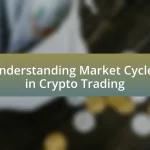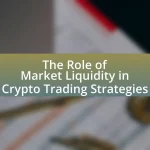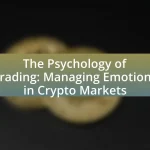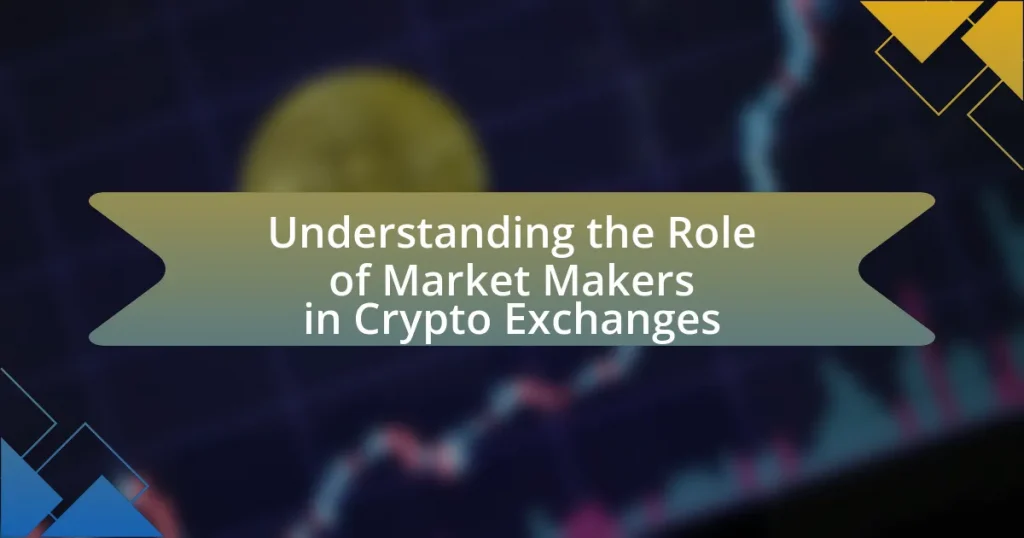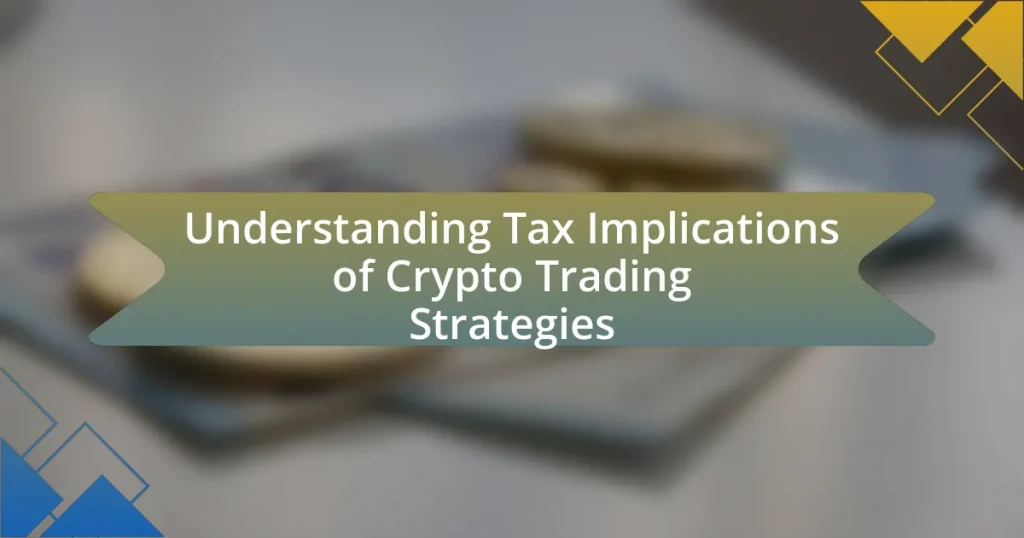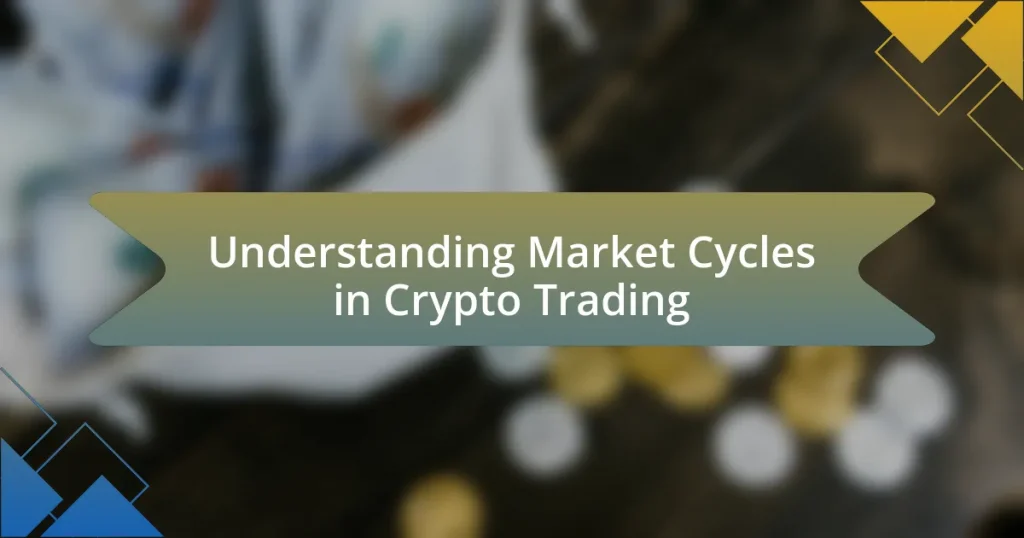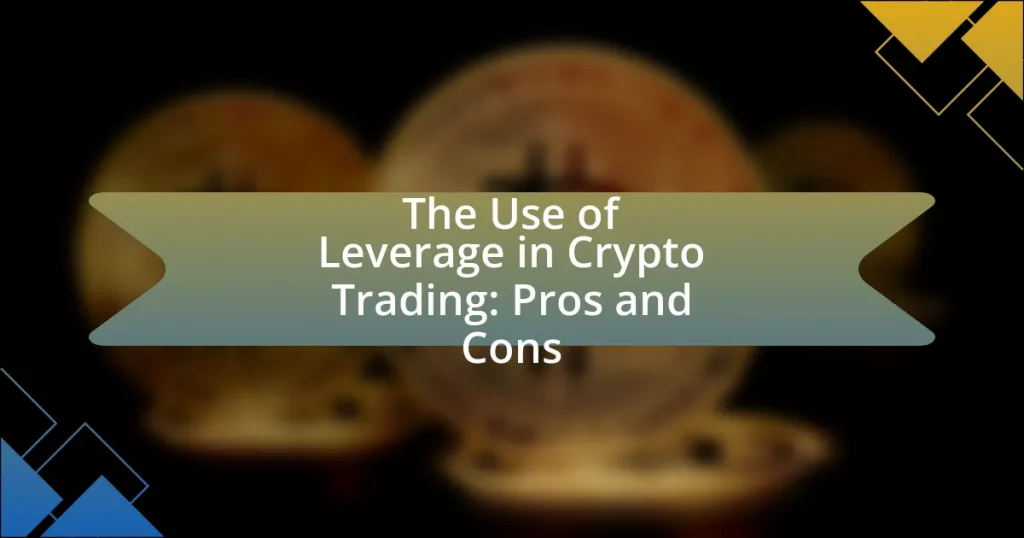Market makers in crypto exchanges are essential entities that provide liquidity by continuously buying and selling cryptocurrencies, facilitating smoother transactions and stabilizing prices. They operate by placing buy and sell orders, profiting from the spread between these prices, and their presence is crucial for maintaining market efficiency and reducing volatility. The article explores how market makers function, the strategies they employ, the challenges they face, and the best practices they should follow to optimize their trading strategies in the dynamic environment of cryptocurrency markets. Additionally, it highlights the impact of regulatory changes and the importance of risk management in their operations.

What are Market Makers in Crypto Exchanges?
Market makers in crypto exchanges are entities or individuals that provide liquidity to the market by continuously buying and selling cryptocurrencies. They facilitate trading by placing buy and sell orders, ensuring that there is always a market for traders to execute their transactions. Market makers profit from the spread between the buying and selling prices, which helps stabilize prices and reduce volatility. Their presence is crucial for maintaining efficient markets, as they enable smoother transactions and improve overall market depth.
How do Market Makers operate within crypto exchanges?
Market makers operate within crypto exchanges by providing liquidity to the market through the continuous buying and selling of cryptocurrencies. They achieve this by placing buy and sell orders at various price levels, which helps to narrow the bid-ask spread and facilitate smoother trading for other participants. Market makers profit from the difference between the buying price and the selling price, known as the spread, and they often hold significant amounts of cryptocurrency to ensure they can fulfill orders quickly. This role is crucial in maintaining market efficiency and stability, as evidenced by the fact that exchanges with active market makers typically experience higher trading volumes and reduced price volatility.
What roles do Market Makers play in providing liquidity?
Market makers play a crucial role in providing liquidity by continuously offering to buy and sell assets at specified prices, thereby facilitating smoother transactions in the market. They maintain an inventory of assets and use their capital to ensure that there are always available buy and sell orders, which helps to narrow the bid-ask spread. This activity not only enhances market efficiency but also reduces price volatility, as evidenced by studies showing that markets with active market makers experience lower fluctuations in asset prices. By fulfilling these functions, market makers contribute significantly to the overall stability and functionality of crypto exchanges.
How do Market Makers influence price stability in crypto markets?
Market makers influence price stability in crypto markets by providing liquidity and facilitating trades. They achieve this by continuously placing buy and sell orders, which helps to narrow the bid-ask spread and reduce price volatility. For instance, during periods of high trading activity, market makers can absorb excess buy or sell pressure, preventing sharp price fluctuations. Their presence ensures that there are always orders available, which stabilizes prices and allows for smoother market operations. This role is crucial, especially in the relatively volatile crypto markets, where the absence of market makers can lead to significant price swings.
Why are Market Makers essential for crypto exchanges?
Market makers are essential for crypto exchanges because they provide liquidity, ensuring that there are always buyers and sellers available for trades. This liquidity facilitates smoother transactions, reduces price volatility, and enhances the overall trading experience for users. By continuously quoting buy and sell prices, market makers help maintain an orderly market, which is crucial for attracting more participants and fostering trust in the exchange. Their presence can significantly narrow the bid-ask spread, making trading more efficient and cost-effective for investors.
What advantages do Market Makers offer to traders?
Market makers provide liquidity to traders, enabling smoother transactions and reducing price volatility. By continuously offering buy and sell orders, market makers ensure that traders can execute trades quickly without significant price changes. This liquidity is crucial in crypto exchanges, where trading volumes can fluctuate dramatically. Additionally, market makers often narrow the bid-ask spread, which lowers trading costs for traders. For instance, in highly liquid markets, the bid-ask spread can be as low as a few cents, making it more cost-effective for traders to enter and exit positions.
How do Market Makers contribute to market efficiency?
Market makers contribute to market efficiency by providing liquidity and reducing price volatility. They facilitate trades by continuously offering to buy and sell assets, which narrows the bid-ask spread and allows for quicker transactions. This active participation helps ensure that prices reflect available information, as market makers adjust their quotes based on supply and demand dynamics. Research indicates that markets with higher levels of market maker activity experience lower volatility and tighter spreads, enhancing overall market efficiency. For example, a study by the CFA Institute found that increased market maker presence leads to improved price discovery and reduced transaction costs, validating their crucial role in maintaining efficient markets.
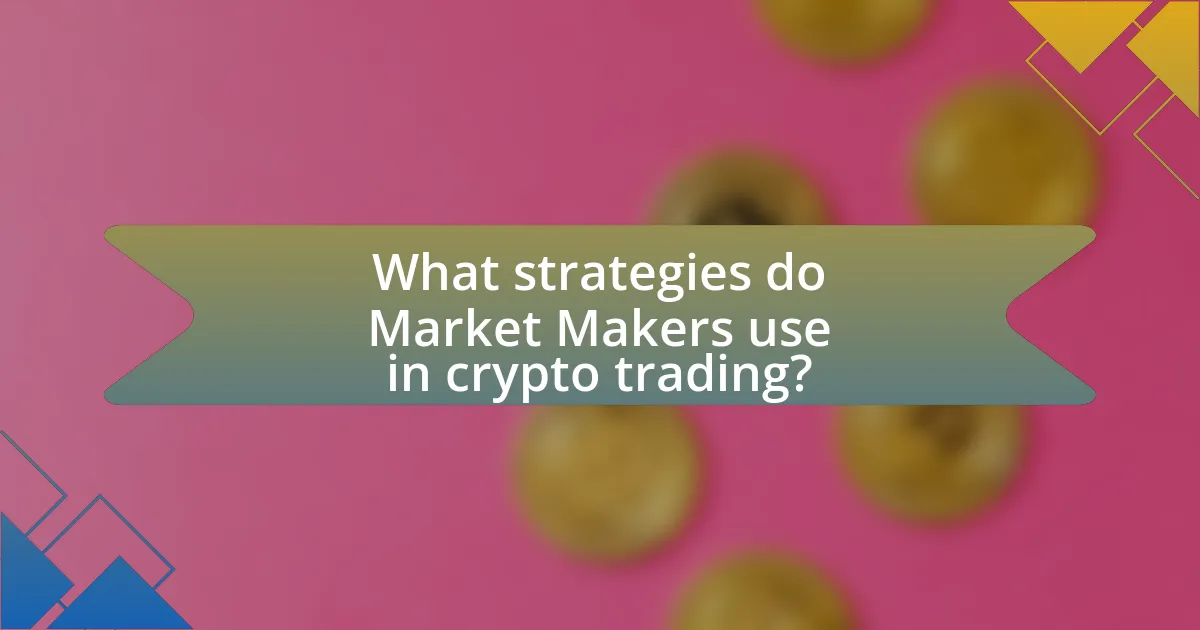
What strategies do Market Makers use in crypto trading?
Market makers in crypto trading employ several strategies to maintain liquidity and facilitate transactions. One primary strategy is the use of bid-ask spreads, where market makers set buy (bid) and sell (ask) prices to profit from the difference. This strategy is essential for ensuring that there is always a market for buyers and sellers, thus enhancing liquidity.
Another strategy involves algorithmic trading, where market makers utilize automated systems to execute trades based on predefined criteria, allowing for rapid response to market changes. This method helps in managing risk and optimizing trade execution.
Additionally, market makers often engage in arbitrage, taking advantage of price discrepancies across different exchanges. By buying low on one platform and selling high on another, they can generate profits while contributing to price stabilization across markets.
These strategies are supported by the need for market makers to manage inventory effectively, ensuring they hold sufficient assets to meet trading demands while minimizing exposure to market volatility.
How do Market Makers set their bid and ask prices?
Market makers set their bid and ask prices based on supply and demand dynamics, market conditions, and their own inventory levels. They analyze current market trends, trading volumes, and price movements to determine competitive bid and ask prices that attract buyers and sellers. For instance, if demand for a cryptocurrency increases, a market maker may raise the ask price to maximize profit while adjusting the bid price to maintain liquidity. This pricing strategy ensures that they can facilitate trades efficiently while managing their risk exposure.
What factors influence the pricing strategies of Market Makers?
Market makers’ pricing strategies are influenced by factors such as market volatility, liquidity, order flow, and competition. Market volatility affects the risk associated with holding assets, prompting market makers to adjust prices to mitigate potential losses. Liquidity determines how easily assets can be bought or sold without impacting their price; higher liquidity typically leads to tighter spreads. Order flow, which reflects the volume and direction of trades, informs market makers about supply and demand dynamics, allowing them to set prices accordingly. Lastly, competition among market makers can drive pricing strategies, as they may lower spreads to attract more trading volume. These factors collectively shape how market makers establish their pricing in crypto exchanges.
How do Market Makers manage risk in volatile markets?
Market makers manage risk in volatile markets by employing strategies such as hedging, adjusting spreads, and utilizing algorithmic trading. Hedging involves taking offsetting positions in correlated assets to mitigate potential losses from price fluctuations. For instance, if a market maker holds a long position in a cryptocurrency, they may short the same asset or a related one to protect against adverse price movements.
Additionally, market makers adjust their bid-ask spreads based on market volatility; wider spreads can compensate for increased risk during turbulent periods. This practice is supported by empirical data showing that wider spreads correlate with higher volatility, allowing market makers to maintain profitability despite fluctuating prices.
Moreover, algorithmic trading systems enable market makers to react quickly to market changes, executing trades at optimal prices and minimizing exposure to sudden market shifts. Research indicates that algorithmic trading can enhance liquidity and reduce the impact of volatility on trading strategies, further validating the effectiveness of these risk management techniques.
What tools and technologies do Market Makers utilize?
Market makers utilize advanced trading algorithms, high-frequency trading platforms, and liquidity management systems. These tools enable them to efficiently execute trades, manage risk, and provide liquidity in various markets. For instance, trading algorithms analyze market data in real-time to identify profitable trading opportunities, while high-frequency trading platforms facilitate rapid order execution, often in milliseconds. Additionally, liquidity management systems help market makers maintain optimal levels of liquidity, ensuring they can meet market demand effectively.
How do algorithmic trading systems assist Market Makers?
Algorithmic trading systems assist Market Makers by automating the process of quoting prices and executing trades, which enhances liquidity and reduces spreads. These systems analyze vast amounts of market data in real-time, allowing Market Makers to respond quickly to price changes and market conditions. For instance, according to a study by the CFA Institute, algorithmic trading can increase market efficiency by providing continuous price updates, which helps Market Makers maintain competitive bid-ask spreads. This automation not only improves the speed of transactions but also minimizes human error, enabling Market Makers to manage risk more effectively and optimize their trading strategies.
What role does data analysis play in Market Making strategies?
Data analysis is crucial in market making strategies as it enables market makers to assess market conditions, identify trading opportunities, and manage risks effectively. By analyzing historical price data, trading volumes, and order book dynamics, market makers can optimize their bid-ask spreads and improve liquidity. For instance, a study by the CFA Institute highlights that data-driven decision-making can enhance profitability by allowing market makers to respond swiftly to market fluctuations and adjust their strategies accordingly. This reliance on data analysis ensures that market makers maintain competitive advantages in volatile environments, ultimately contributing to more efficient markets.
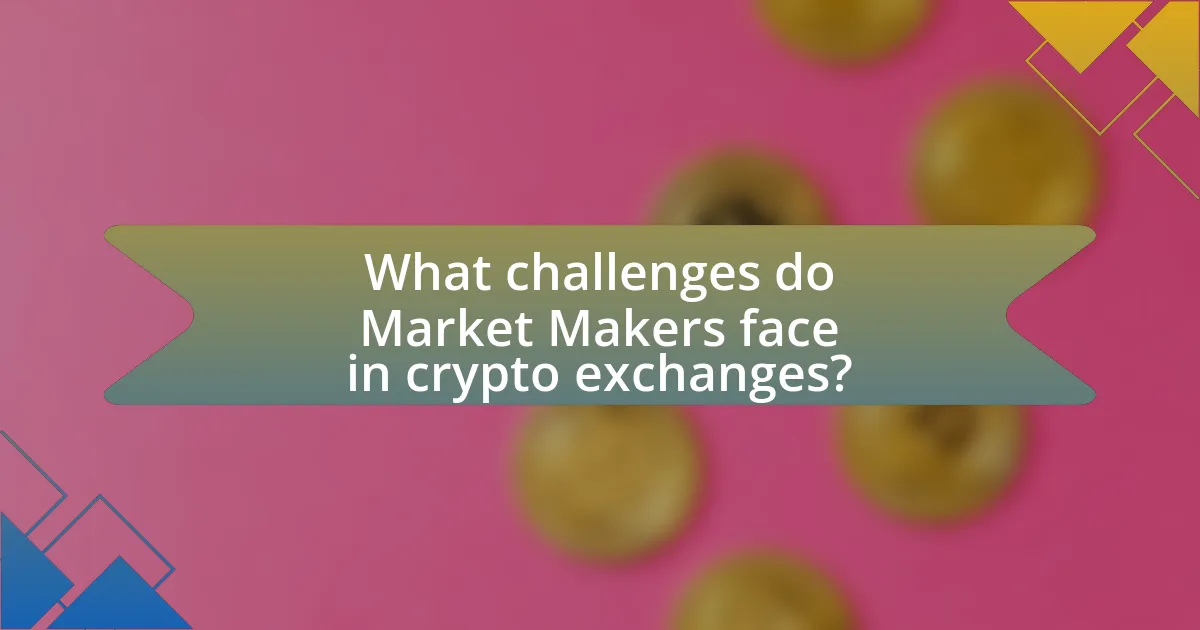
What challenges do Market Makers face in crypto exchanges?
Market makers in crypto exchanges face significant challenges, including high volatility, regulatory uncertainty, and liquidity issues. High volatility can lead to rapid price fluctuations, making it difficult for market makers to maintain profitable spreads. Regulatory uncertainty varies by jurisdiction and can impact operational strategies, as market makers must adapt to changing laws and compliance requirements. Additionally, liquidity issues arise when trading volumes are low, which can hinder the ability to execute trades efficiently and at desired prices. These challenges are compounded by the relatively nascent nature of the cryptocurrency market, which lacks the stability seen in traditional financial markets.
How do regulatory changes impact Market Makers?
Regulatory changes significantly impact market makers by altering their operational frameworks and compliance requirements. For instance, increased regulations can lead to higher costs for market makers due to the need for enhanced compliance systems and reporting mechanisms. A study by the International Organization of Securities Commissions (IOSCO) in 2020 highlighted that stricter regulations often result in reduced liquidity in markets, as some market makers may exit due to the increased burden. Additionally, regulatory changes can affect the types of assets that market makers are willing to trade, as they may avoid assets that face heightened scrutiny or restrictions.
What compliance issues must Market Makers navigate?
Market Makers must navigate several compliance issues, including anti-money laundering (AML) regulations, know your customer (KYC) requirements, and adherence to securities laws. These regulations are designed to prevent illicit activities and ensure transparency in financial transactions. For instance, AML regulations require Market Makers to monitor transactions for suspicious activity, while KYC mandates that they verify the identities of their clients to prevent fraud. Additionally, compliance with securities laws is crucial, as Market Makers must ensure that their trading practices do not violate regulations set forth by authorities such as the Securities and Exchange Commission (SEC). Failure to comply with these regulations can result in significant penalties, including fines and loss of trading privileges.
How do Market Makers adapt to changing market conditions?
Market makers adapt to changing market conditions by adjusting their bid-ask spreads, inventory levels, and trading strategies. When market volatility increases, market makers may widen their spreads to account for the higher risk, ensuring they maintain profitability. Additionally, they actively manage their inventory to avoid excessive exposure to price fluctuations, often employing algorithms to analyze market data and execute trades efficiently. For instance, during periods of high trading volume or significant price movements, market makers utilize real-time analytics to recalibrate their strategies, ensuring they remain competitive and can provide liquidity. This adaptability is crucial for maintaining their role in facilitating trades and stabilizing the market.
What are the risks associated with being a Market Maker?
The risks associated with being a Market Maker include significant financial exposure, market volatility, and liquidity risk. Market Makers provide liquidity by continuously buying and selling assets, which exposes them to potential losses if market prices move unfavorably. For instance, during periods of high volatility, the price of an asset can fluctuate rapidly, leading to substantial losses if a Market Maker cannot adjust their positions quickly enough. Additionally, liquidity risk arises when a Market Maker is unable to execute trades at desired prices due to insufficient market activity, which can further exacerbate financial losses. Historical data shows that during market downturns, Market Makers can face increased challenges, as seen in the 2018 cryptocurrency market crash, where many experienced significant losses due to rapid price declines and reduced trading volumes.
How can Market Makers mitigate financial risks?
Market makers mitigate financial risks by employing strategies such as hedging, maintaining liquidity, and utilizing sophisticated algorithms for price discovery. Hedging allows market makers to offset potential losses by taking opposite positions in correlated assets, thereby reducing exposure to adverse price movements. Maintaining liquidity ensures that they can facilitate trades without significant price fluctuations, which minimizes the risk of large losses during volatile market conditions. Additionally, the use of algorithms enables market makers to analyze market trends and execute trades efficiently, further reducing the likelihood of financial losses. These practices are essential for sustaining their operations and managing the inherent risks associated with market fluctuations.
What operational risks do Market Makers encounter?
Market makers encounter several operational risks, including liquidity risk, technology risk, and counterparty risk. Liquidity risk arises when market makers are unable to buy or sell assets quickly enough to prevent losses, particularly during volatile market conditions. Technology risk involves potential failures in trading systems or software, which can lead to missed opportunities or erroneous trades. Counterparty risk is the possibility that the other party in a transaction may default, impacting the market maker’s financial position. These risks are critical as they can significantly affect the profitability and operational efficiency of market makers in crypto exchanges.
What best practices should Market Makers follow?
Market makers should follow best practices such as maintaining liquidity, managing risk effectively, and utilizing advanced trading algorithms. Maintaining liquidity involves consistently providing buy and sell orders to facilitate trading, which helps stabilize prices and attract more participants. Effective risk management includes setting appropriate limits on exposure and employing hedging strategies to mitigate potential losses. Utilizing advanced trading algorithms allows market makers to execute trades quickly and efficiently, optimizing their operations in fast-moving markets. These practices are essential for ensuring a successful market-making strategy in the dynamic environment of crypto exchanges.
How can Market Makers optimize their trading strategies?
Market makers can optimize their trading strategies by employing advanced algorithms and data analytics to enhance liquidity and reduce spreads. These algorithms analyze market trends, order book dynamics, and historical price movements to make informed trading decisions. For instance, a study by the CFA Institute found that market makers using algorithmic trading can achieve up to 30% better execution prices compared to manual trading methods. Additionally, market makers can implement risk management techniques, such as hedging and diversification, to mitigate potential losses while maintaining a competitive edge in volatile markets.
What tips can enhance the effectiveness of Market Makers in crypto exchanges?
To enhance the effectiveness of Market Makers in crypto exchanges, they should implement advanced algorithms for pricing and liquidity management. These algorithms enable Market Makers to respond quickly to market changes, ensuring competitive spreads and optimal order execution. Additionally, maintaining a diverse portfolio of assets allows Market Makers to mitigate risks associated with volatility in specific cryptocurrencies. Historical data shows that Market Makers who utilize automated trading strategies can achieve higher profitability, as evidenced by a study from the Journal of Finance, which indicates that algorithmic trading can improve market efficiency and reduce transaction costs.

